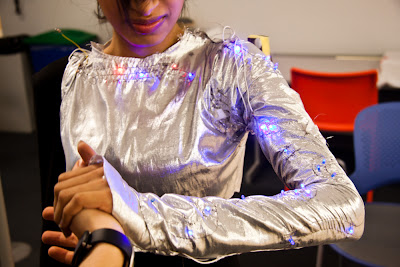VIEW PROJECT VIDEO.
READ FULL PAPER.
There are a few different interactions the shirt portrays. First, when human contact is made on the hand, the lights fire up the sleeve and neck and began to pulse. As long as there is skin contact the lights remain pulsing. Once the contact stops, the lights slowly stop pulsing, one section at a time, starting from the wrist and ending at the neck. As most of the lights are blue, we have sewn in red lights at the neck area to represent blushing on the face. The other interaction is focused on the shoulder. Whether the wearer is touched intentionally on the shoulder or is unintentionally bumped, the lights pulse briefly. However, when the wearer is repeatedly bumped or contacted on the shoulder, such as in a crowded area, the lights rapidly flicker for that moment as if the person is startled or overwhelmed.
The touch interaction from the hand contact is done by sewing conductive fabric onto the fabric on the hand. This is connected to the Power (5V) and Pin 0 threads sewn onto the shirt, and connected to the Arduino which is placed at the back of the shirt. The contact on the shoulder is done by making a pressure switch with sponge and conductive fabric. When pressure is applied and the conductive fabric touches through the switch, the circuit completes and the lights turn on.
The shirt has a unique and fitted aesthetic. We have emphasized on an asymmetrical form where the neckline extends past the shoulder up to the height of the wearer's ear, giving a slightly futuristic feel. It is composed of a few layers. The first layer is a reflective silver fabric where the soft circuit and LED lights are sewn into the left arm and torso along the neckline. The arm has an additional layer of the silver fabric to help diffuse the LED's for a softer, more delicate aesthetic of the blinking lights. Another layer of a thinly knit, translucent black fabric has been added to the arm that helps to balance the rest of the shirt and neck made of black leather-like material, which ultimately holds the form. The raised neck is also comprised of the leather material, the reflective silver material to cast the lights onto the face which overlays a stiffer white material to hold the shape.
Our technical implementation also went through a variety of stages. First, we had the entire circuit sewn into the shirt, with wires only connecting to the Arduino when they needed to. This resulted in some finicky circuits as we realized that many of the main lines to be wired to the Arduino were sewn right underneath the armpit area. This area was most the susceptible to creasing and causing the conductive thread to come into contact with one another! Consequently, the circuit would be on all the time leaving the sensors useless. We thought of a solution to insulate the conductive thread with fabric glue to prevent the short circuiting, however this ended up making the circuit stop working completely. We ended up having to take some of the shirt apart and hardwire most of the circuit to ensure its functionality. As a result, we have a beautifully constructed wearable garment that reacts upon human contact.
In future iterations we are looking to make this garment more easily wearable for the wearer, and also make the circuits more permanent. We would also like to do some user research by wearing the garment in social situations, interacting with people, and getting their reactions and insights after experiencing the garment. We look forward to further improving our design.
In future iterations we are looking to make this garment more easily wearable for the wearer, and also make the circuits more permanent. We would also like to do some user research by wearing the garment in social situations, interacting with people, and getting their reactions and insights after experiencing the garment. We look forward to further improving our design.








